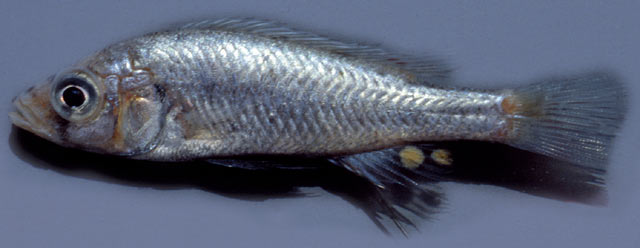Scientists from the Naturalis Biodiversity Center and the Institute of Biology Leiden, the Netherlands, have found two new species of cichlid fish in Lake Victoria, Tanzania.

This image shows a male of the new species Haplochromis argens (Frans Witte / de Zeeuw MP et al)
In 1985, biologists from the Institute of Biology Leiden made a survey in the Tanzanian part of the lake to establish the status of the rapidly declining cichlids. During this expedition Dr Tijs Goldschmidt studied the egg spots on the anal fin of cichlids for their possible role in the rapid speciation of these fish.
In the Emin Pasha Gulf, among a species nicknamed Haplochromis “argens”, individuals were found with aberrant egg dummies and lacking red in the fins. Just the kind of example Dr Goldschmidt was looking for to test his theory of speciation by sexual selection. The aberrant individuals were provisionally named H. “dusky argens”.
A taxonomic description was never made and whether H. “dusky argens” was a separate species or a color morph remained unclear. In 1987, most cichlid species from the offshore waters of the lake had disappeared, and with them the urge of taxonomic descriptions.
Now, 25 years later, about a quarter of the cichlid species have recovered in the “Nile perch desert”, some of them became even more abundant than in the past, but the former common H. “argens” is still extremely rare.
The status of H. “dusky-argens” is unknown as it was only caught in the remote Emin Pasha Gulf, which is not sampled nowadays. Research on successfully resurgent species shows that they were able to adapt morphologically to the new environmental conditions. Their body shape, for instance, changed, so that burst swimming to escape predators improved. Preliminary results suggest that such a response is not found in H. “argens”.

This image shows a male of the new species Haplochromis goldschmidti (Frans Witte / de Zeeuw MP et al)
The above observations triggered the present taxonomic study as a baseline for further research. It shows that several taxonomic characters differ more between the co-occurring populations of H. “argens” and H. “dusky argens” in the Emin Pasha Gulf, than between populations from different locations. This suggests that they are indeed two species, which are morphologically driven apart at places where they co-occur.
In case of H. “argens” the nickname was upgraded to the formal name, while H. “dusky-argens” is now named H. goldschmidti. Description of the newly identified species appears in the journal ZooKeys.
_______
Bibliographic information: de Zeeuw MP et al. 2013. Two new species of zooplanktivorous haplochromine cichlids from Lake Victoria, Tanzania. ZooKeys 256: 1–34; doi: 10.3897/zookeys.256.3871







